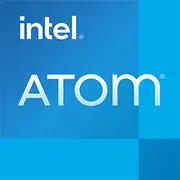Intel Atom Z3740

Intel Atom Z3740: Review and Practical Guide for Buyers in 2025
Introduction
Intel Atom Z series processors have always been associated with compact and energy-efficient devices. Released in 2013, the Atom Z3740 gained popularity in budget tablets and ultra-portable laptops. Even in 2025, devices based on this chip still appear on the market. Let’s explore who this chip is suitable for and whether it’s worth considering in the era of ARM processors and hybrid architectures.
1. Architecture and Process Technology
The Heart of Bay Trail-T
The Atom Z3740 belongs to the Bay Trail-T generation and is built using a 22nm process. It is a quad-core processor without Hyper-Threading support (4 threads), which is typical for the Atom lineup. Each core is based on the Silvermont microarchitecture, optimized for low power consumption.
- Clock Frequencies: Base — 1.33 GHz, turbo mode — up to 1.86 GHz. However, due to a TDP of 2 watts, the boost is temporary.
- Integrated Graphics: Intel HD Graphics (Gen 7) with 4 execution units (EU) and a frequency of up to 667 MHz. It supports DirectX 11 but struggles with even simple games from the 2020s.
Architecture Features:
- The lack of AVX instructions limits performance in modern applications.
- Supports 64-bit operating systems (Windows 10/11, Linux), but with drivers from 2013–2015.
2. Power Consumption and TDP
Efficiency Above All
The 2W TDP is a key feature of the Z3740. This enables passive cooling and allows the chip to be integrated into devices with batteries from 20 Wh. However, the low TDP has a downside: under load (e.g., video rendering), the processor quickly hits thermal limits and reduces frequencies.
Power-Saving Technologies:
- Intel SpeedStep — dynamic frequency scaling.
- C-states — disabling unused cores.
3. Performance
Real Tasks vs. Synthetic Benchmarks
Geekbench 6 shows modest results: 143 points (single core) and 341 (multi-core). In comparison, the Apple A14 Bionic (2020) scores around ~1600 points in the single-core test.
- Office Work: Basic tasks (Word, Excel, browsing with 5-7 tabs) are performed adequately, but with delays when multiple programs are running simultaneously.
- Multimedia: Playback of 1080p/60fps video (H.264) is possible, but 4K or HEVC will cause lag.
- Gaming: Only older games (e.g., Half-Life 2) at low settings. CS:GO gives 15-20 FPS at 720p.
Turbo Mode: A temporary "boost" to 1.86 GHz helps with short-term tasks (like opening applications), but under prolonged load, the frequency drops back to the base.
4. Use Cases
Who Is the Z3740 Suitable For in 2025?
- Students: For lectures, working with texts and PDFs.
- Retirees: Simple tasks: email, video calls, reading news.
- Secondary Device: A compact tablet for travel.
Not Suitable For:
- Modern gaming and video editing.
- Running neural network applications (e.g., Stable Diffusion).
5. Battery Life
Long Lasting, With Caveats
Devices with the Z3740 (e.g., ASUS Transformer Book T100) still offer 8–10 hours of battery life with moderate use in 2025. However, battery wear (after 10+ years of use) reduces this time to 4–6 hours.
Energy Saving:
- Disable Turbo Boost.
- Utilize power-saving modes in Windows/Linux.
6. Comparison with Competitors
Who Else Is in the Game?
- AMD A4-5000 (2013): Four Jaguar cores, 15W TDP. Better graphics (Radeon HD 8330), but higher power consumption.
- Apple A7 (2013): Double single-core performance, but the iOS ecosystem limits usage.
- Intel Pentium Silver N5030 (2019): 6W TDP, 4 Goldmont Plus cores. Geekbench 6 Multi-Core — ~1200 points.
Conclusion: Z3740 falls behind even budget chips from 2019-2024 (e.g., Intel N100), but wins on price.
7. Strengths and Weaknesses
Strengths:
- Device pricing: $150–$300 (new Windows 11 tablets).
- Passive cooling — complete silence.
- Support for 64-bit operating systems.
Weaknesses:
- No support for Wi-Fi 6 and USB-C.
- Maximum 4 GB RAM (architecture limitation).
- Outdated drivers.
8. Laptop Selection Tips
What to Look for in 2025?
- Device Type: 2-in-1 tablets (e.g., Chuwi HiBook) or ultrabooks with 10–12 inch displays.
- RAM: Look for models with 4 GB (less will cause slowdowns).
- Storage: Ensure an SSD (even eMMC is outdated).
- Display: IPS matrix with a resolution of 1920x1200 — comfortable for the eyes.
Examples of New Devices:
- Jumper EZbook X3: 11.6", 4 GB, 128 GB SSD — $199.
- Onda V820W: Windows tablet with keyboard — $179.
9. Final Verdict
The Intel Atom Z3740 in 2025 is a choice for those seeking an extremely low-cost device for basic tasks. Its advantages include:
- Extremely low price.
- Sufficient performance for web and office work.
- Exceptional battery life.
Who It’s Suitable For:
- Users looking for a "digital notebook."
- Parents buying a first laptop for their child.
- Retro tech enthusiasts.
Alternatives: If your budget allows $300–400, consider devices with Intel N100 or AMD Mendocino — they are 3-4 times more powerful.
Conclusion: The Atom Z3740 is a relic of the past, but it proves that even 12 years after its release, technologies can remain relevant in niche scenarios. The key is to clearly understand your needs.
Basic
CPU Specifications
Memory Specifications
GPU Specifications
Benchmarks
Compared to Other CPU
Share in social media
Or Link To Us
<a href="https://cputronic.com/cpu/intel-atom-z3740" target="_blank">Intel Atom Z3740</a>